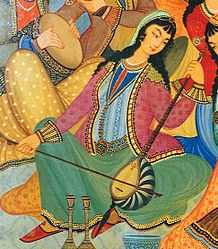This article is about the Iranian instrument.
For the Indian instrument, see
santoor.

Santur Technique Video.theora
|
Concertino for Santur and Orchestra, by Faramarz Payvar and Hossein Dehlavi.
|
| Problems playing this file? See media help. |

Woman playing the santur in a painting from the Hasht-Behesht Palace in Isfahan Iran, 1669

Ancient Babylonian Santur Drawing of Relief
Santur (Persian: سنتور, also santūr, santour, santoor) is an Iranian hammered dulcimer, consisting of a trapezoidal box of horizontal strings, played with small mallets known as mezrab. The Iranian classical santur has 72 strings of brass or copper and steel, 18 sets of four tuned in unison, with two or three rows of bridges providing a range of some three octaves.[1][2]
A variant of the instrument is played in Turkey. Similar types of hammered dulcimer are found widely spread in Europe and Asia; the Indian santoor is wider, more rectangular and has more strings.
Characteristics
The term santoor is of unclear etymology, though theories include the meaning "one hundred strings" in Persian,[3][4] or derivation from the Greek term psalterion.[1]
Two rows of nine bridges called kharak (literally "little donkey") divide the santur into three positions. Over each bridge crosses four strings spanning horizontally across the right and left side of the instrument.[5] The Iranian santur is primarily tuned to a variety of different diatonic scales utilizing quarter tones, which are used in the twelve dastgahs (modes) of Iranian classical music called the radif.[6][7]
Notable players
Iran
Outside Iran
- Japan
See also
References
- ↑ 1.0 1.1 Habib Hassan Touma; Habib Touma (1 January 2003). The Music of the Arabs. Amadeus Press. pp. 125–. ISBN 978-1-57467-081-3.
- ↑ American Lutherie: The Quarterly Journal of the Guild of American Luthiers. The Guild. 2007. pp. 31–38. - Modern santur design, however, is most likely no more than two centuries old. In this article, we focus on the design that is most popular in contemporary Iran or Persia. The santur provides over three octaves of musical notes (e-f'"
- ↑ Compiled (2008). Awakening Indians to India (Paperback). Chinmaya Mission. pp. 300–. ISBN 978-81-7597-434-0.
- ↑ Somnath Dhar (1999). Jammu and Kashmir. National Book Trust, India. p. 135. ISBN 978-81-237-2533-8. - The most favoured instrument is the 100- stringed santoor (san means 'hundred' and toor, is strings, in Persian)
- ↑ Jean Claude Sillamy (1976). Histoire de l'évolution du langage musical. J.-C. Sillamy. p. 52. - Ces chevalets - appelés Kharak-s , "petits ânes", sont divisés en 2 rangées de 9, entre lesquelles se situent le registre grave
- ↑ New Outlook. New Century Foundation. 1958. p. 290. - Unlike occidental music, the santur is tuned to quarter tones which make it sound strange to Western ears
- ↑ Paul M. Gifford (13 June 2001). The Hammered Dulcimer: A History. Scarecrow Press. pp. 51–. ISBN 978-1-4616-7290-6. - ...compiled volumes of the radif, or repertoire on which improvisation is based, for the santur
- ↑ Kiani, Majid. "Master of the Santur". Santur Master, Teacher & Performer.
- ↑ Khan, Hassan. "Santur Master". Old school Santur Master.
- ↑ Azarmina, Pejman. "Santur Player". Santur Player.
- ↑ Azarmina, Pejman. "Santur Player and Composer". Santur Player and Composer.
- ↑ Tani, Dr. Masato. "Japanese Santur Player". Ethnomusicology.
Further reading
Heydarian, P.; J.D. Reiss (2005). "The Persian music and the santur instrument". Proceedings of Sixth International Conference on Music Information Retrieval, London, UK 11. pp. 524–527.
External links
|
|---|
| | East Asia | |
|---|
| | Non-east Asia & Africa | |
|---|
| | Europe | |
|---|
| | Americas | |
|---|
|







